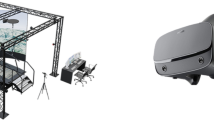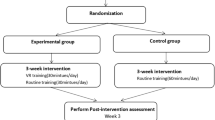Abstract
Virtual reality (VR) during gait training in people post-stroke can offer added value by providing a task-specific training in more interactive and motivating environments. Nevertheless, scarce research has been presented concerning more detailed information about the influence immersive VR has on the gait pattern of stroke survivors. This exploratory study was conducted to examine the effect of walking with immersive VR on the gait pattern while walking on a self-paced treadmill in people post-stroke. Spatiotemporal gait parameters (i.e. walking speed, stride time, step width, step length) and gait variability measures of stride time, ankle, knee and hip range of motion were analyzed. Our preliminary results suggest that walking with immersive VR can positively influence spatiotemporal gait parameters. The addition of VR introduced less step-by-step variability in joint kinematics in both patients. More research with a larger sample size is necessary.
Access this chapter
Tax calculation will be finalised at checkout
Purchases are for personal use only
Similar content being viewed by others
References
E.J. Benjamin et al., Heart disease and stroke statistics-2017 update: a report from the American Heart Association. Circulation 135(10), e146–e603 (2017)
J. Mehrholz, S. Thomas, B. Elsner, Treadmill training and body weight support for walking after stroke. Cochrane Database Syst. Rev. 8, Cd002840 (2017)
D. Cano Porras, P. Siemonsma, R. Inzelberg, G. Zeilig, M. Plotnik, Advantages of virtual reality in the rehabilitation of balance and gait: systematic review. Neurology 90(22), 1017–1025 (2018)
M.C. Howard, A meta-analysis and systematic literature review of virtual reality rehabilitation programs. Comput. Hum. Behav. 70, 317–327 (2017)
E. De Keersmaecker, N. Lefeber, M. Geys, E. Jespers, E. Kerckhofs, E. Swinnen, Virtual reality during gait training: does it improve gait function in persons with central nervous system movement disorders? A systematic review and meta-analysis. NeuroRehabilitation 44(1), 43–66 (2019)
D. Katsavelis, L. Decker, N. Kochi, N. Stergiou, Effect of optic flow produced by virtual reality on gait variability. J. Sport Exerc. Psychol. 30, S97–S98 (2008)
Acknowledgements
E. De Keersmaecker and D. Rodriguez-Cianca are both Strategic Basic Research fellows funded by the Research Foundation Flanders (FWO).
Author information
Authors and Affiliations
Corresponding author
Editor information
Editors and Affiliations
Rights and permissions
Copyright information
© 2022 The Author(s), under exclusive license to Springer Nature Switzerland AG
About this paper
Cite this paper
De Keersmaecker, E. et al. (2022). How to Challenge Patients During Gait Training: The Effect of Immersive Virtual Reality on the Gait Pattern in People Post-stroke. In: Torricelli, D., Akay, M., Pons, J.L. (eds) Converging Clinical and Engineering Research on Neurorehabilitation IV. ICNR 2020. Biosystems & Biorobotics, vol 28. Springer, Cham. https://doi.org/10.1007/978-3-030-70316-5_1
Download citation
DOI: https://doi.org/10.1007/978-3-030-70316-5_1
Published:
Publisher Name: Springer, Cham
Print ISBN: 978-3-030-70315-8
Online ISBN: 978-3-030-70316-5
eBook Packages: EngineeringEngineering (R0)




